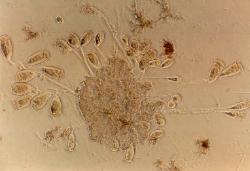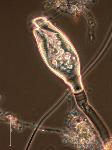Effect of anoxia and anaerobia on protozoan communities
in activated sludge operation
in activated sludge operation
Background: Both the density and the structure of the protozoan community affect the process
performance and efficiency of the wastewater treatment in terms of final effluent BOD, turbidity and pathogen
concentration. Protozoa are sensitive to environmental change brought about by changes in influent quality
or operating conditions, which can lead to an alteration in their community structure that can subsequently
affect performance. With the implementation of biological nutrient removal (BNR), involving anaerobic and
anoxic stages, the impact of these new conditions on the activated sludge protozoan community requires
further exploration.
Objectives: The aim of this project is to investigate the ability of protozoan species to tolerate anoxia and
anaerobia. Furthermore optimal process conditions should be established that ensure maximum treatment
performance and optimal protozoal structure.
Project: After the development of a reliable enumeration method for protozoan ciliates a survey of 11 full-
scale wastewater treatment plants (WWTPs) was conducted to determine the typical ciliates inhabiting
different Irish activated sludge plants. By measuring a wide range of design and operational/management
factors it was examined whether different plant designs, especially conventional and BNR systems, support
different protozoan communities.
For the laboratory based research on protozoan communities a novel laboratory scale WWTP consisting of 4
batch reactors was constructed and subsequently validated in terms of physico-chemical variation between
the reactors and the protozoan community variability.
Employing different length and frequencies of anoxia and anaerobia the lab scale plant was used to establish
optimal process conditions with minimal effect on the protozoan community. A variety of sludges from
different plants have been used to identify species that are able to survive anaerobic conditions and that
dominate a community that is frequently exposed to anaerobia within a treatment cycle.
Using all the data collected from both the plant study and the lab based experiments allows an attempt to be
made to model the response of protozoa in relation to anoxia and anaerobia. This will permit more effective
process management resulting in optimum treatment capability.
Publications:
performance and efficiency of the wastewater treatment in terms of final effluent BOD, turbidity and pathogen
concentration. Protozoa are sensitive to environmental change brought about by changes in influent quality
or operating conditions, which can lead to an alteration in their community structure that can subsequently
affect performance. With the implementation of biological nutrient removal (BNR), involving anaerobic and
anoxic stages, the impact of these new conditions on the activated sludge protozoan community requires
further exploration.
Objectives: The aim of this project is to investigate the ability of protozoan species to tolerate anoxia and
anaerobia. Furthermore optimal process conditions should be established that ensure maximum treatment
performance and optimal protozoal structure.
Project: After the development of a reliable enumeration method for protozoan ciliates a survey of 11 full-
scale wastewater treatment plants (WWTPs) was conducted to determine the typical ciliates inhabiting
different Irish activated sludge plants. By measuring a wide range of design and operational/management
factors it was examined whether different plant designs, especially conventional and BNR systems, support
different protozoan communities.
For the laboratory based research on protozoan communities a novel laboratory scale WWTP consisting of 4
batch reactors was constructed and subsequently validated in terms of physico-chemical variation between
the reactors and the protozoan community variability.
Employing different length and frequencies of anoxia and anaerobia the lab scale plant was used to establish
optimal process conditions with minimal effect on the protozoan community. A variety of sludges from
different plants have been used to identify species that are able to survive anaerobic conditions and that
dominate a community that is frequently exposed to anaerobia within a treatment cycle.
Using all the data collected from both the plant study and the lab based experiments allows an attempt to be
made to model the response of protozoa in relation to anoxia and anaerobia. This will permit more effective
process management resulting in optimum treatment capability.
Publications:
- Dubber, D. and Gray, N.F. (2011) The influence of fundamental design parameters on ciliates community structure in
Irish activated sludge systems
- Dubber, D. and Gray, N.F. (2011) The effect of anoxia and anaerobia on ciliate community in biological nutrient removal
systems using laboratory-scale sequencing batch reactors (SBRs). Water Research, 45, (6), 2213 – 2226. - Dubber, D. and Gray, N.F. (2010) Replacement of chemical oxygen demand (COD) with total organic carbon (TOC) for
monitoring wastewater treatment performance to minimize disposal of toxic analytical waste. J. Environ. Sci. Health,
Part A, 45, (12), 1595-1600. - Dubber, D. and Gray, N.F. (2009) Enumeration of protozoan ciliates in activated sludge: Determination of replicate
number using probability. Water Research, 43, 3443-3452.
Donata Dubber
Centre for the Environment, TCD
contact: dubberd@tcd.ie
Funded: Science Foundation Ireland.
Centre for the Environment, TCD
contact: dubberd@tcd.ie
Funded: Science Foundation Ireland.

Opercularia microdiscum
Carchesium polypinum
| Water Technology Research Group Trinity College Dublin 1980-2010 thirty years of research, training and consultancy |
| Donata was awarded her PhD in 2011 and is currently working on domestic treatment systems in Ireland. |


